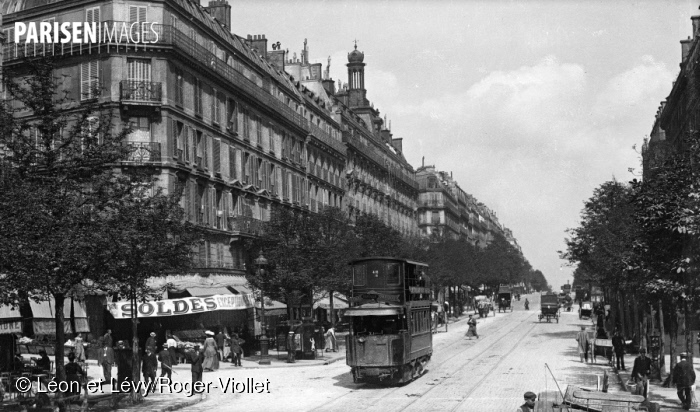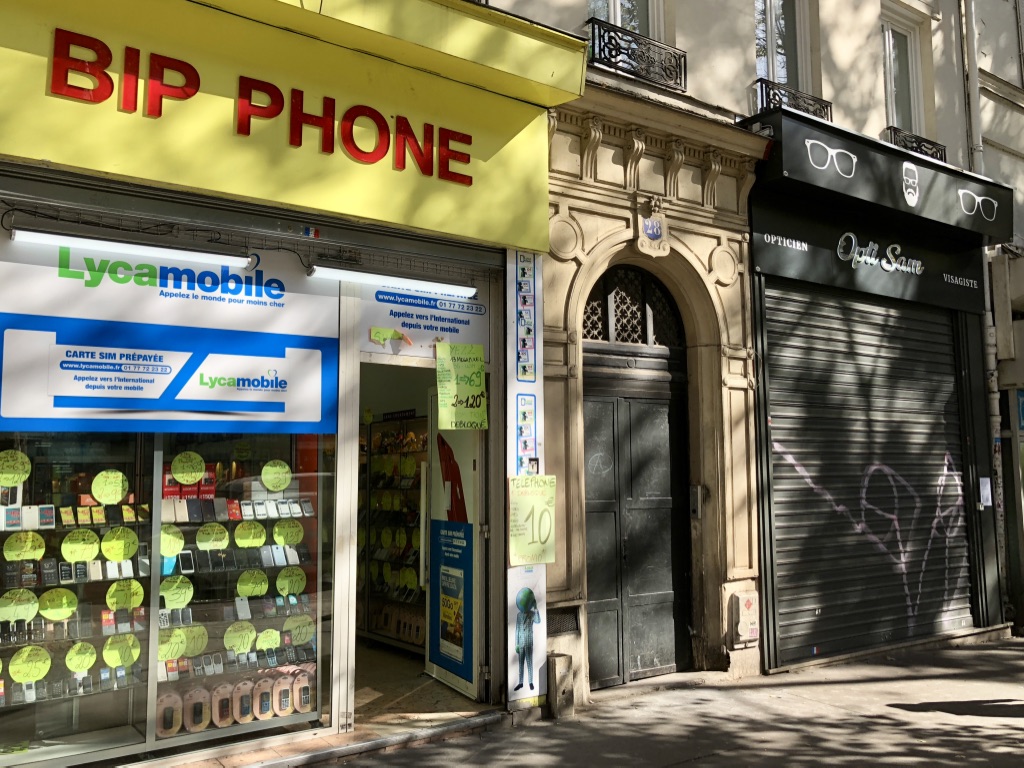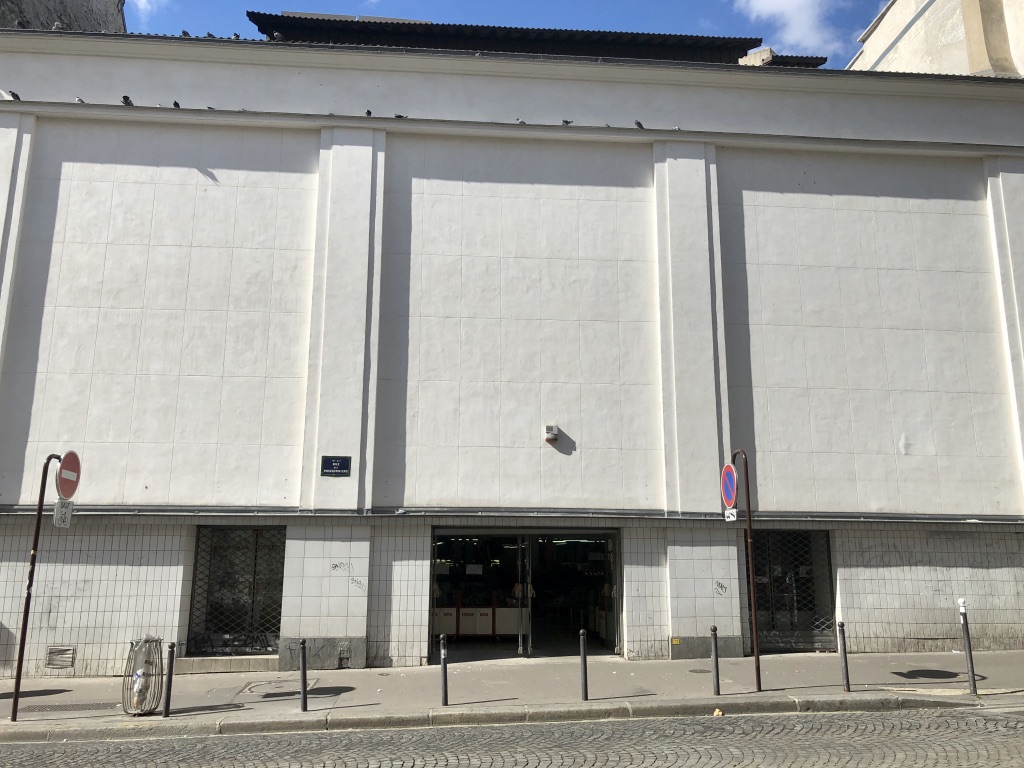Sounds In and Around L’Église Saint-Merri
IF YOU’VE READ Victor Hugo’s novel Les Misérables you will have read Hugo’s fictional account of the June Rebellion or the Paris Uprising of 1832, the last outbreak of violence linked with the July Revolution of 1830.
Général Jean Maximilien Lamarque had been a French commander during the Napoleonic Wars and had served with distinction in many of Napoleon’s campaigns. But following the July Revolution of 1830 he had become a leading critic of the new constitutional monarchy of Louis Philippe. In Les Misérables, Victor Hugo views Lamarque as the government’s champion of the poor. He says that Lamarque was “loved by the people because he accepted the chances the future offered, loved by the mob because he served the emperor well”. Hugo portrays Lamarque as an emblem of French pride and honour.
In 1832, a cholera epidemic spread across France and Lamarque fell victim to it. He died on 1st June. Because of his status as a Republican and Napoleonic war hero, his death provided the spark that led the revolutionaries to take to their barricades.
On the 5th and 6th June 1832, Paris saw two bloody days of rioting with the Société des amis du peuple, la Société des droits de l’homme, students, craftsmen and labourers playing a principal part. But as early as the evening of 5th the Army and the National Guard had begun to suppress the uprising. By the following day fierce fighting centered on the last remaining pocket of resistance in the Rue du Cloitre-Saint-Merri beside the Église Saint-Merri, but this too was finally suppressed.
Over the two days of the uprising some 800 people were killed or wounded.

Rue du Cloitre-Saint-Merri
The rue du Cloitre-Saint-Merri dates from the 12th century. It was originally called Rue de la Porte Saint-Merri, because it was next to l’Arche Saint-Merri, a 10th century gate through the second wall to encircle Paris.
By the 14th century, the street had become one of many streets in Paris noted for its prostitutes; at least it was until the parish priests of Saint-Merri demanded, not altogether successfully, that they be expelled.
Today, rue du Cloitre-Saint-Merri runs for 132 metres from rue du Renard to rue Saint-Martin. For much of its length it runs alongside the northern side of the Église Saint-Merri.
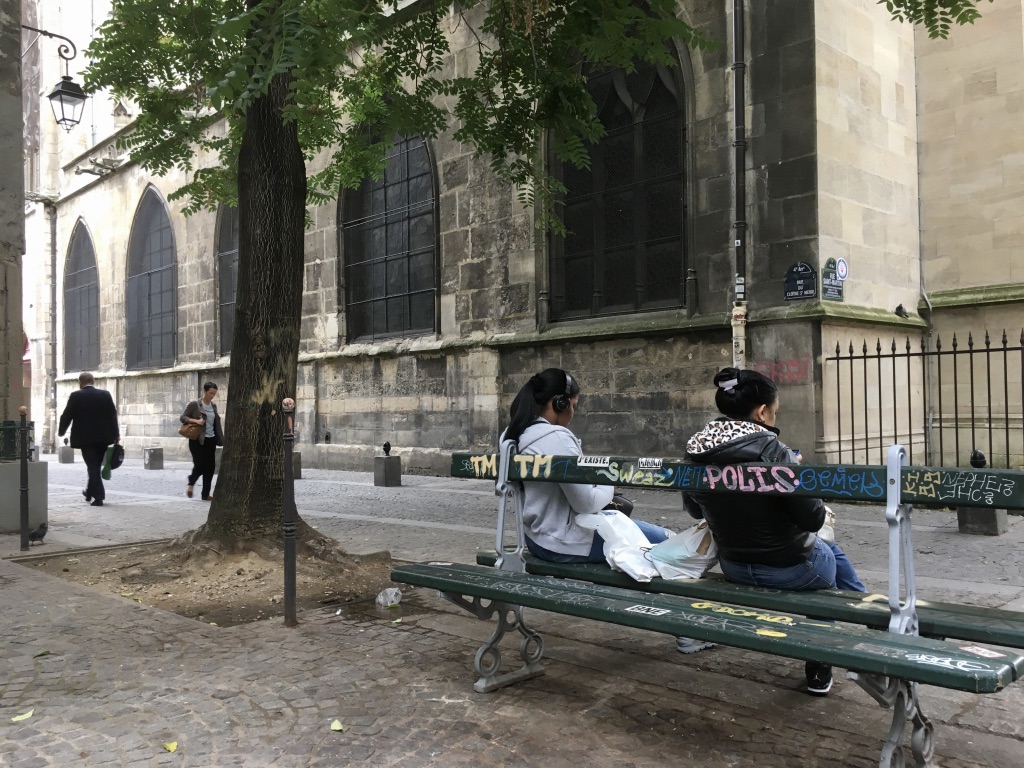
At its junction with rue Saint-Martin, the rue du Cloitre-Saint-Merri ends with a small square noted for its ever-changing street art.
It was around this small square that some of the bloodiest fighting of the Paris uprising took place, and it was here that I chose to sit on a bench partly to reflect on the events of 1832 and partly to absorb the elaborate 16th century gothic architecture of the Église Saint-Merri standing next to me.
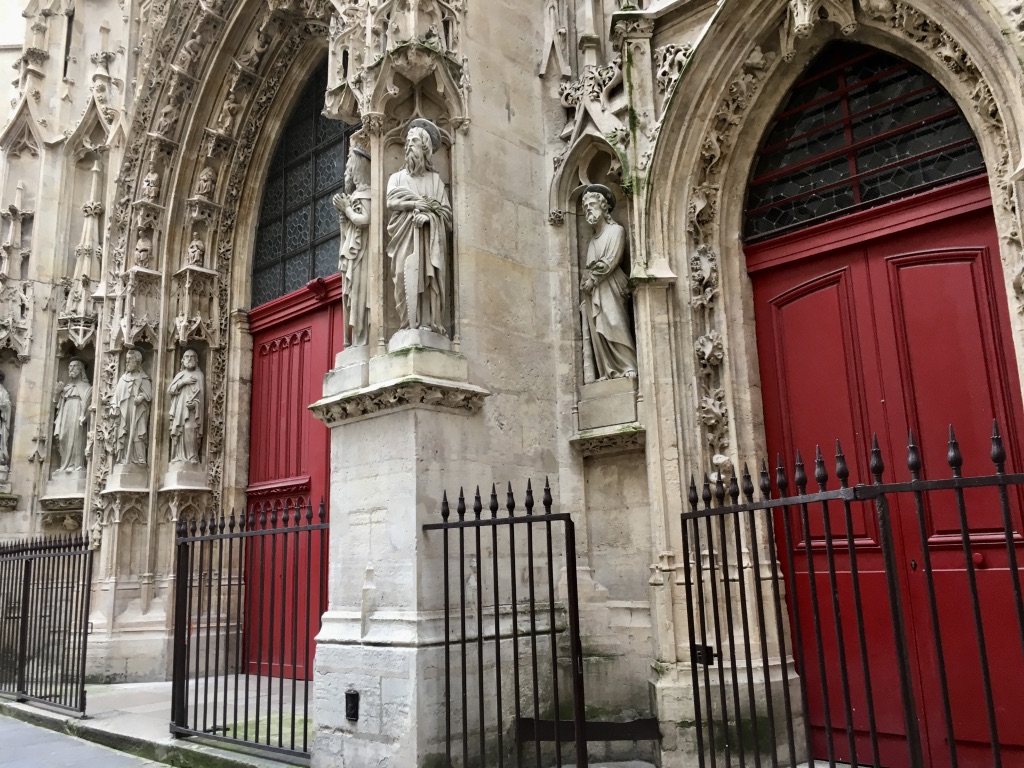
Église Saint-Merri
For someone wired up like me it’s impossible not to contemplate history without conjuring up images of the sounds associated with that history. What would this place have sounded like I wondered in June 1832, or when the Église Saint-Merri was in its Middle-Ages pomp, or even when rue du Cloitre-Saint-Merri was a 14th century rue aux ribaudes?
Unfortunately, from my Parisian green bench my imagined historical sounds were overwhelmed by the contemporary sounds around me – 16th century stonemasons replaced by 21st century Chinese building contractors.
Sounds around l’ Église Saint-Merri:

If you make it to the end of this sound piece you will discover that at least a flicker of the Parisian revolutionary spirit still survives: a lone voice of protest is heard as the whining of the weapon of mass construction reappears.

Although the Église Saint-Merri we see today dates from the mid-16th century, its roots go much further back.
Tradition has it that Medericus, abbot of the Abbey of Saint-Martin d’Autun, came to live as a hermit in a hut near the Saint-Pierre-des-Bois oratory which stood on the site of the present church. He is said to have died in August 700 and was buried there. He was later canonised and renamed Saint-Médéric.
In 884, Goslin, the bishop of Paris, had Médéric’s remains exhumed and laid to rest in the Saint-Pierre-des-Bois oratory, which now became the Saint-Médéric chapel. It was at this time that Saint-Médéric became the patron saint of the Right Bank.
Over time, the name Médéric was contracted to Merri, which is why the Église Saint-Merri and the rue du Cloitre-Saint-Merri are so named.
Today, the remains of Saint-Médéric still rest in the crypt of the church.

In the early 10th century, a new church, Saint-Pierre-Saint-Merri, was built at the instigation of Eudes Le Fauconnier. Styled as a ‘Royal Officer’, it is possible that this was the same Eudes Le Fauconnier who took part in the defence Paris during the Viking siege in 885-86.
During the rebuilding of the church in the sixteenth century, the skeleton of a warrior was discovered together with boots of gilded leather and the inscription:
“Hic jacet vir bonæ memoriæ Odo Falconarius fundator hujus ecclesiæ”.
Which, based upon my schoolboy Latin, means something like:
“Here lies Eudes Le Fauconnier, of fond memory, founder of this church”.

The present day Église Saint-Merri was built between 1515 and 1612. The crypt, the nave and the aisles date from 1515-1520, the transept crossing from 1526-1530 and the choir and the apse were completed in 1552.
Some restoration work was carried out in the 18th century; some of the broken arches were repaired, the floor was covered with marble and the stained-glass windows were partly replaced by white glass.
During the French Revolution the church was closed for worship and was used to make saltpetre, one of the constituents of gunpowder. From 1797 to 1801, Theophilanthropists made it a “Temple of Commerce”. Theophilanthropists were a deistic society established in Paris during the period of the Directory aiming to institute in place of Christianity, which had been officially abolished, a new religion affirming belief in the existence of God, in the immortality of the soul, and in virtue.
The church was returned to the Catholic worship in 1803.
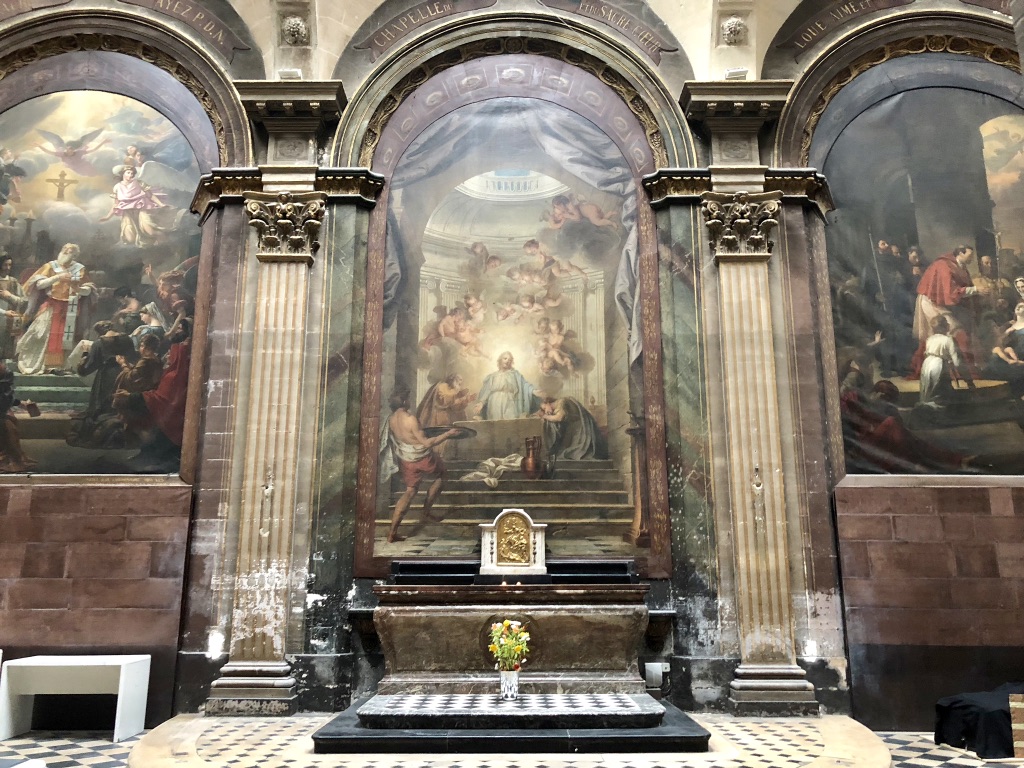
Sounds inside the Église Saint-Merri:

The northern aspect of the Église Saint-Merri and the bell tower
Image par Mbzt — Travail personnel, CC BY-SA 3.0, https://commons.wikimedia.org/w/index.php?curid=13660170
The bell-tower was built with three floors in 1612 but, following a fire in 1871, it was reduced to two floors. This bell tower houses the oldest bell in Paris dating from 1331.
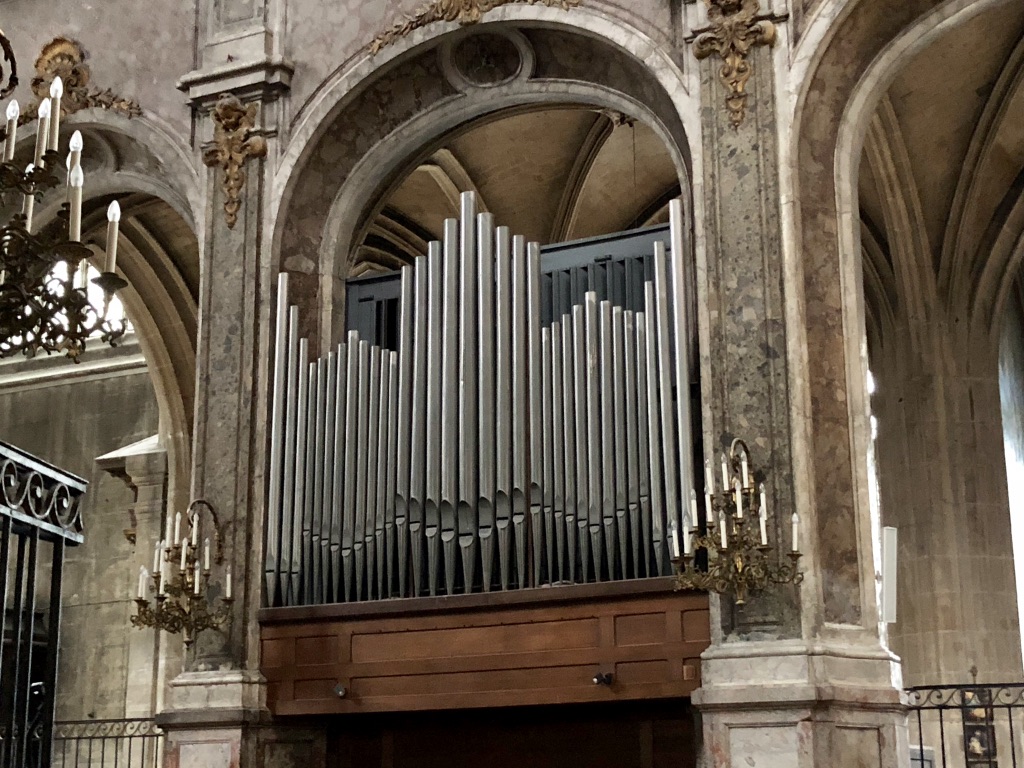
The Choir Organ
The Église Saint-Merri has two organs, a choir organ and a grand orgue de tribune.
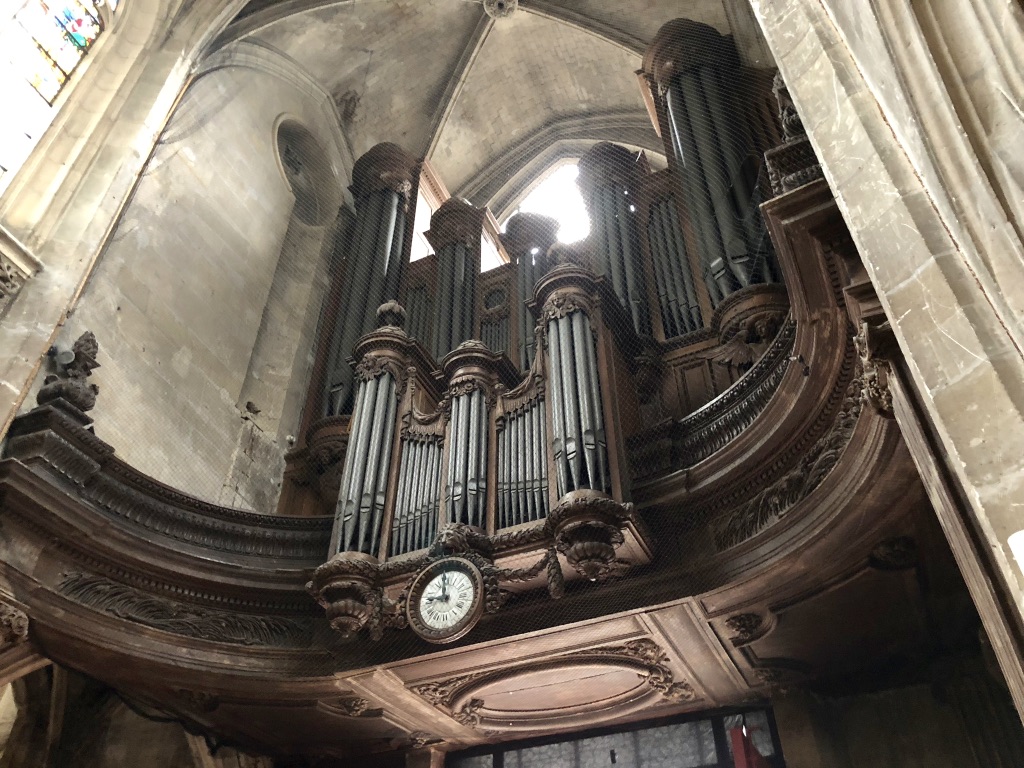
The grand orgue de tribune
François de Heman built the tribune organ with its five turrets between 1647 and 1650 and the master carpenter Germain Pilon crafted the turret buffet in 1647.
The instrument was enlarged by François-Henri Clicquot in 1779, and then rebuilt from 1855 to 1857 by Aristide Cavaillé-Coll. Further work was carried out in 1947 by Victor Gonzalez.
Camille Saint-Saëns was the organist at the Église Saint-Merri from 1853 to1857.

My exploration of the sounds in and around the Église Saint-Merri took me from Medericus, a hermit living in a hut and subsequently canonised, to Eudes Le Fauconnier and the 9th century Viking siege of Paris, to the craftsmen of the 16th and 17th century, to the oldest bell in Paris, to a church used for making gunpowder and the bloody events of the Paris Uprising of 1832. And let’s not forget the medieval Parisian street with its ‘ladies of the night’ and the modern day Chinese builders.
Which goes to show that following contemporary sounds can lead in many different directions.
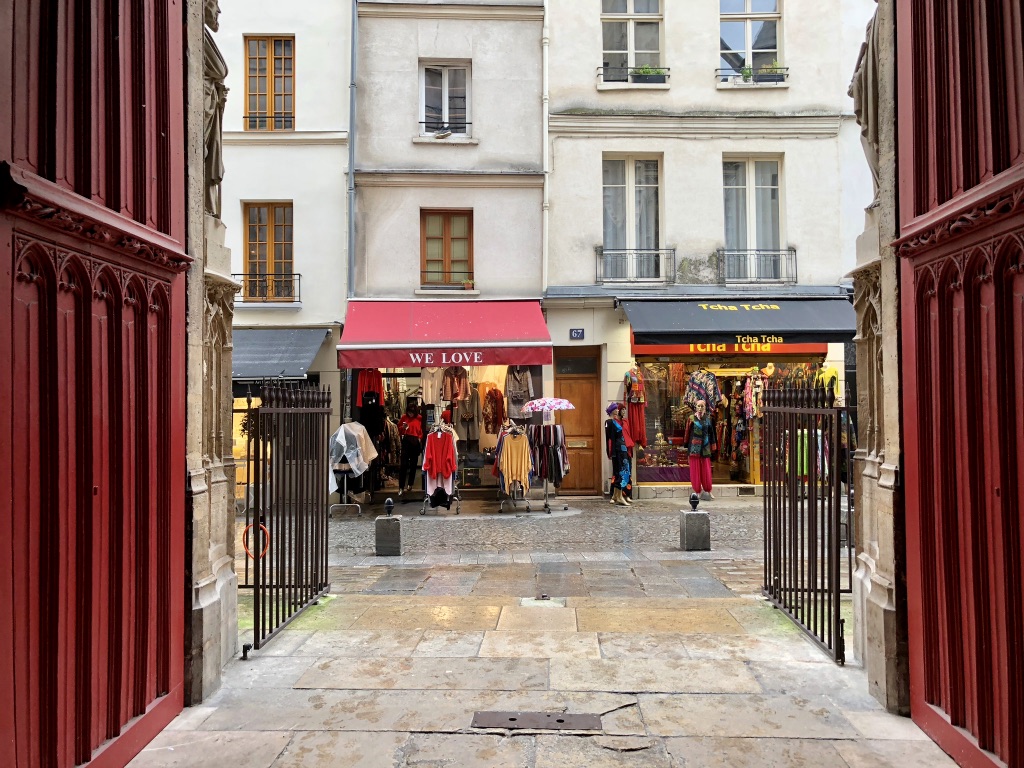
The Passage Molière and its Sounds
BECAUSE IT’S NEVER HAD a roof, the Passage Molière doesn’t qualify as one of the surviving Parisian passages couverts, the covered passageways built mainly in the first half of the nineteenth century. What the Passage Molière can claim though is that it predates all the one hundred and fifty original passages couverts.

Passage Molière from rue Quincampoix
The oldest Parisian passage couvert, the Passage des Panoramas, opened in 1799 whereas the Passage Molière dates back to 1791.
The Passage des Panoramas and the Passage Molière do have something in common though: both house a theatre. The Passage des Panoramas is one of the twenty surviving passages couverts and it is still home to the Théâtre des Variétés, while the Passage Molière is home to the Théâtre Molière from which the passage takes its name.
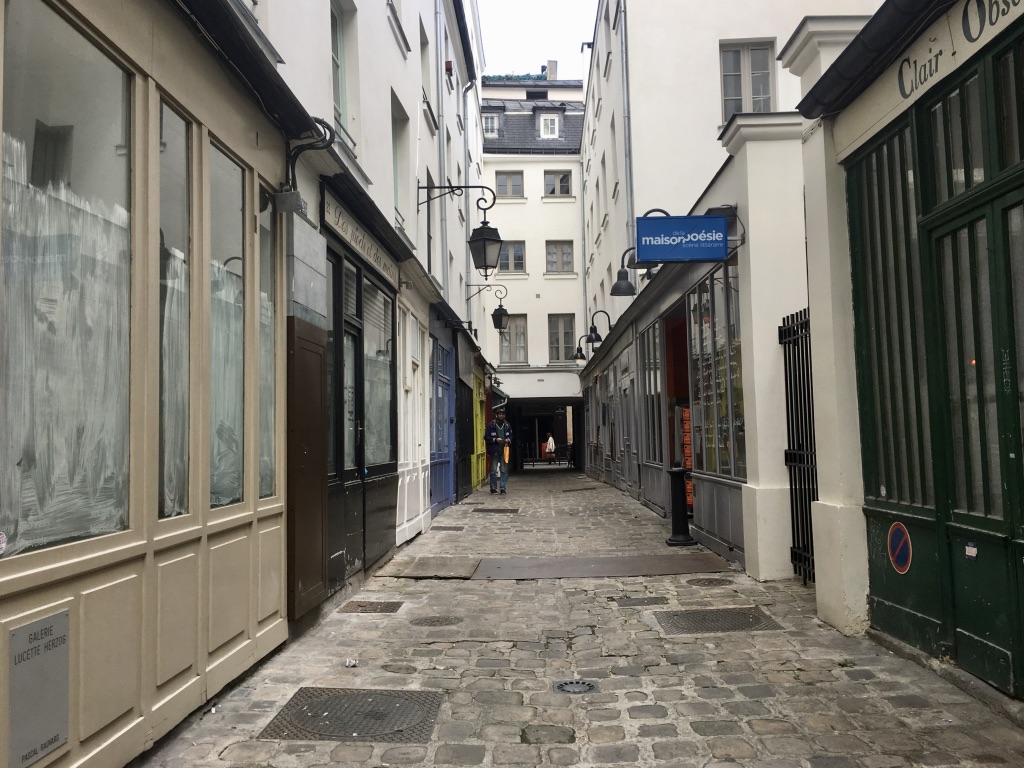
The Théâtre Molière was founded by the French actor, playwright, theatre director, businessman and revolutionary, Jean François Boursault-Malherbe. It opened on 18th June 1791 with a performance of Molière’s The Misanthrope, a satire about the hypocrisies of French aristocratic society and the flaws that all humans possess.
Unfortunately, the theatre was not a resounding success. It closed in August 1792 and then underwent several changes of management and several changes of name, although Boursault retained the ownership. The theatre became variously known as the Théâtre des Sans-culottes, Théâtre de la rue Saint-Martin, Théâtre des Artistes en société, Théâtre des Amis des arts et de l’Opéra-Comique and Théâtre des Variétés nationales et étrangères.
The theatre’s fortunes recovered a little at the turn of the century thanks to several notable actors being persuaded to perform there including Thomas Sheridan, but in 1807 it was closed again and became a hall for concerts, banquets and balls.
The theatre opened yet again in 1831 but in the revolutionary climate of 1848 it was occupied by the Club patriotique du 7e arrondissement for political meetings and thereafter was abandoned and fell into oblivion for more than a century.
Eventually, the City of Paris authorities stepped in and restored the theatre back to its original eighteenth century architecture. Today, the theatre forms part of the Maison de la Poésie – Scène littéraire in the Passage Molière.
Founded in 1983, La Maison de la Poésie was created for the creation and dissemination of, and events about, contemporary poetry.

Sounds in the Passage Molière:

Maison de la Poésie – Scène litteraire
The Passage Molière runs in an east – west direction from 157 rue Saint-Martin to 82 rue Quincampoix. At fifty metres long it cuts through blocks of buildings with each end covered where it passes under the buildings.
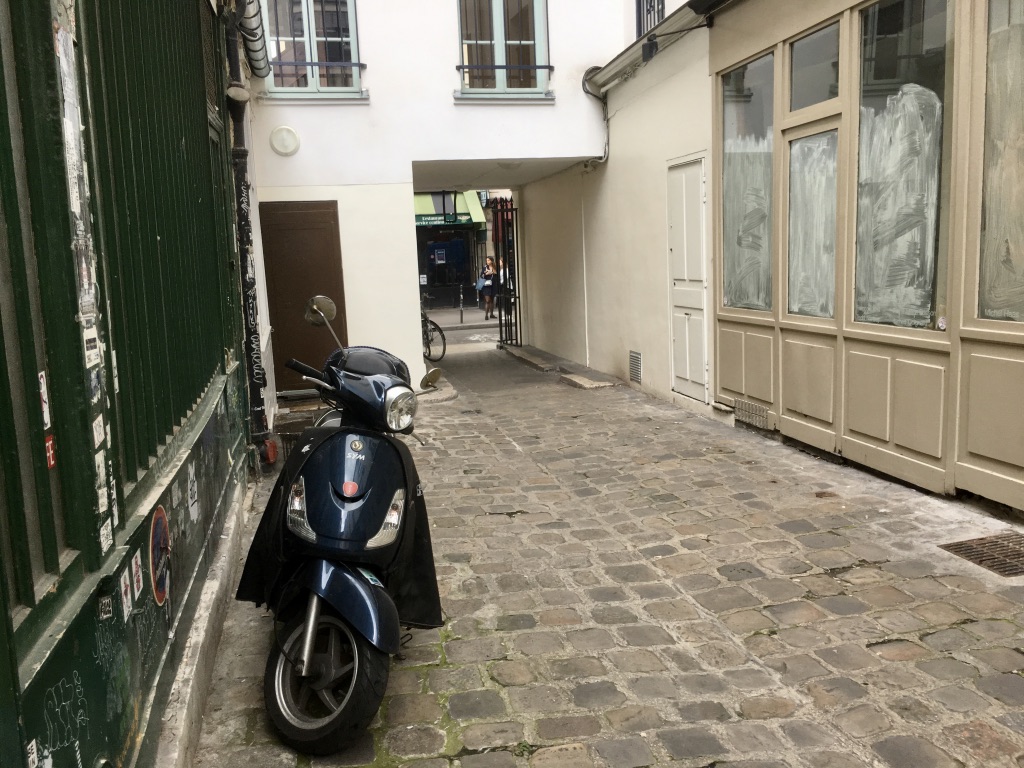
Like the Théâtre Molière, the passage has had several names. During the French Revolution it became the Passage des Sans-Culottes and then the Passage des Nourrices before reverting back to Passage Molière.

I recorded the sounds in the Passage Molière from outside the Maison de la Poésie and the restored Théâtre Molière with rue Saint-Martin to my left and rue Quincampoix to my right. The passage is a relatively quiet oasis amidst the more strident sounds of the surrounding neighbourhood so all I had to do was to give the sounds time to speak and tell their own story.

Walking through the Passage Molière, the attentive observer may notice that the building numbers do not follow the Parisian street numbering convention of even numbers on one side and odd numbers on the other with the lower numbers progressing to the higher numbers in the same direction.
In the Passage Molière, the numbers progress in an anti-clockwise direction. Starting on the right side of the passage at its eastern end, the numbers increase sequentially heading west and then from the western end, the numbers continue sequentially heading east.

Passage Molière from rue Saint-Martin
The City as a Perpetual Concert
SOME NINETEENTH CENTURY OBSERVERS of Paris were quite forthright in their impressions of the sonic tapestry of the city.
For example, the American writer John Sanderson arrived in Paris for the first time in July 1835 and he wasn’t over impressed with what he found …
“All things of this earth seek, at one time or another, repose – all but the noise of Paris. The waves of the sea are sometimes still, but the chaos of these streets is perpetual from generation to generation; it is the noise that never dies.”
John Sanderson, Sketches of Paris: In Familiar Letters to His Friends (1838)
And in 1837, the journalist and flâneuse Delphine de Girandin wrote …
“In Paris today, the day is a perpetual concert, a series of uninterrupted serenades; Parisien ears have not one instant of rest.”
Delphine de Girandin: Lettres parisiennes du Vicomte de Launay: August 25, 1837
For John Sanderson the ‘noise that never dies’ included the sound of the notorious cries de Paris, the often piercing cries of the street traders hawking their wares, as well as the sound of traffic:
“… this rattling of cabs and other vehicles over the rough stones, this rumbling of omnibuses.”
Delphine de Girandin’s ‘perpetual concert’ was aimed at the itinerant street musicians:
“Starting in the morning, the organs of Barbary divide up the neighbourhoods of the city; an implacable harmony spreads over the city. [ … ] Finally, in the evening, great serenades! Violins, galoubets, flutes, guitars, and Italian singers! It’s a concert to die for, and there is no refuge; all this takes place under your window, it’s a residential concert that you cannot possibly avoid.”
And so to Paris in the twenty-first century; has anything changed?
The kind of sounds that John Sanderson and Delphine de Girandin encountered still exist in modern day Paris although the emphasis has changed.
The cries de Paris are now largely confined to the traders in the street markets although one can still come across men (it’s almost always men) calling out ‘Le Monde’ as they meander from café to café selling the afternoon edition of the daily newspaper. The street musicians still ply their trade although not quite so prolifically as in the nineteenth century. And then there’s the traffic! The sound of traffic pervades almost every nook and cranny of the city today and it can be overpowering and it’s perpetual; it really is the noise that never dies.
I spend a lot of time listening to Paris, so the notion of the city as a perpetual concert chimes with me. For me, it’s not just the street music that forms the concert, but rather all the sounds of the city. I see each individual sound, musical or not, as a dot on a score which, when added together, form a complete sonic composition. Or, to use a different metaphor, one might consider individual sounds as the warp and the weft, which, when woven together, form a sonic tapestry depicting the city.
Perhaps I can illustrate the notion of the city as a perpetual concert by recounting my perambulation around a part of Paris last Saturday afternoon.
I began at the Jardin du Luxembourg where I came upon this gentleman playing one of Delphine de Girandin’s organs of Barbary.

Street organ at the Jardin du Luxembourg:

Outside the gates of the Jardin du Luxembourg this little street organ sounds quite charming but, in different circumstances, I take Delphine de Girandin’s point: “ … there is no refuge; all this takes place under your window, it’s a residential concert that you cannot possibly avoid.”
Listening to this street organ, it’s impossible not to notice the pervading background sound of the passing traffic.
So let’s consider the sound of traffic, or as John Sanderson put it: “… this rattling of cabs and other vehicles over the rough stones, this rumbling of omnibuses.”
From the Jardin du Luxembourg, I walked the short distance to the Église Saint-Sulpice and then to the Place Saint-Germain-des-Prés.
The Place Saint-Germain-des-Prés is home to the church of the former Abbey of Saint-Germain-des-Prés, founded in the 6th century, and the famous café Les Deux Magots, once the rendezvous of the literary and intellectual élite of the city.

But for our purposes, the important thing about the Place Saint-Germain-des-Prés is that it is paved with John Sanderson’s rough stones.
When people ask me what my favourite sound of Paris is I usually decline to answer. But if asked what sound most typifies Paris then my answer is unequivocal: “… this rattling of cabs and other vehicles over the rough stones, this rumbling of omnibuses.”

Traffic over the pavé in Place Saint-Germain-des-Prés:

The Place Saint-Germain-des-Prés revealed the sounds of passing cycles, cars, the occasional two-wheeler, a luggage trolley and, with a nod to John Sanderson, at least three omnibuses.
And these sounds deserve to be listened to attentively because, thanks to the pavé, the pervasive, noise polluting, cacophonous traffic noise that blights this city seems to have been transformed into a soporific, almost musical composition.
My guess is that most of the people in Place Saint-Germain-des-Prés on Saturday afternoon were probably unaware of these sounds other than providing them with a faint sonic background to their dash from the church to the café. Yet for someone wired up like me, these sounds not only form part of the perpetual concert but they also screech, Paris!
Having listened so far to modern day examples of Delphine de Girandin’s organs of Barbary and John Sanderson’s rattling of cabs and other vehicles over the rough stones, it’s possible to take the notion of the city as a perpetual concert a stage further.
A few steps away from the Place Saint-Germain-des-Prés is the Rue de l’Abbaye, a street named after the Abbey of Saint-Germain-des-Prés. It’s a narrow street running some 170 metres from Rue Guillaume Apollinaire to Rue de l’Echaudé and, although Paris is a bustling, sound rich city, Rue de l’Abbaye is one of the few streets shrouded in relative quiet.
So can a quiet street like Rue de l’Abbaye contribute to our perpetual concert? To find out, I perched myself on the steps of N° 3 Rue de l’Abbaye, the Institut Catholique de Paris, known in English as the Catholic University of Paris, and began to record.

Sounds in rue de l’Abbaye:

In Rue de l’Abbaye we find the human and avian species intertwined; the footsteps, the voices and the rustle of clothing as people pass by interlaced with the gentle cooing of the pigeons enjoying a late lunch and the flapping of their wings as they flutter to and fro in search of a tastier morsel. The occasional traffic sounds are in proportion to the surrounding ambient sounds rather than dominating them.
It takes concentrated listening to get the most out of these sounds but the effort is worth it because what is revealed is yet another strand to the city as a perpetual concert.
To complete my afternoon’s listening I returned to the Place Saint-Germain-des-Prés and one of Delphine de Girandin’s great serenades! Not the violins, galoubets, flutes, guitars, and Italian singers she referred to but instead, the Dixieland jazz style of the early twentieth century.

Jazz in Place Saint-Germain-des-Prés:

This group of jazz musicians can be found most Saturdays at the southwest corner of Place Saint-Germain-des-Prés entertaining an enthusiastic audience comprising mostly tourists.
In conclusion, I look upon Paris as a city of perpetual concert in which all the sounds the city has to offer, ranging from the loud, brash and often unwelcome to the subtle and understated, are performers of equal value. John Sanderson refers to the noise that never dies and Delphine de Girandin to Parisien ears have not one instant of rest, both of which are true: the city is never without sound so the concert is perpetual. It’s just a question of learning to appreciate it.
Important Listening Note:
It’s a quirk of our times that when we listen to recorded sound we tend to crank up the volume too much. In order for you to appreciate the sounds featured in this post I have set the levels so that the sounds correctly relate to each other. In other words, the sounds will replay at the same level relative to each other as I heard them when they were recorded.
To get the best effect, set the level of your listening device to the sounds of the street organ remembering that less is always more! Then keep your listening device set to the same level for all the other sounds.
Enjoy!

Église Saint-Germain-des-Prés
In and Around Métro Lamarck-Caulaincourt
NAMED AFTER THE FRENCH comedian, humorist and member of the French Resistance, rue Pierre Dac is just 23 metres long making it one of the shortest streets in Paris. Originally forming the upper part of rue de la Fontaine-du-But linking rue Lamarck and rue Caulaincourt in the 18th arrondissement, the street’s name was changed in 1995 in honour of Pierre Dac.

The distinctive red sign in rue Pierre Dac points us towards the Métro station Lamarck-Caulaincourt and tells us that this station once formed part of the three Paris Métro lines owned by the Nord-Sud Company, or to give it its proper name, la Société du chemin de fer électrique souterrain Nord-Sud de Paris. In 1931, the Nord-Sud Company was taken over by its competitor, la Compagnie du chemin de fer métropolitain de Paris, which in turn was nationalised in 1948.
The Métro station Lamarck-Caulaincourt is perhaps best known for its distinctive entrance nestling between the two staircases that form most of rue Pierre Dac.

Lamarck-Caulaincourt station was opened on 31st October 1912 and today it forms part of the Paris Métro Line 12 linking the stations Front Populaire in the north to Issy-les-Moulineaux in the south. The station platforms were renovated in 2000 – 2001 and further work was carried out in 2006.

Lamarck-Caulaincourt platform before renovation

Lamarck-Caulaincourt platform today
Since Lamarck-Caulaincourt station was constructed under the butte Montmartre, the large hill that forms the village of Montmartre, it’s not surprising that the station platforms are some 25 metres below the station entrance. For those who arrive at the station by train and find the 25-metre climb out of the station a challenge, RATP have thoughtfully provided a lift to make life easier.

Sounds around Lamarck-Caulaincourt station platforms and an exit by lift:

I recorded the sounds inside the station to add to my extensive archive of sounds of the Paris Métro network but I also recorded sounds from the staircases in rue Pierre Dac outside the station, which I found to be equally fascinating.
I sat on one of the staircases and simply observed life passing by just as the photographer did in the 1925 photograph below.

L’entrée de la station de métro Lamarck-Caulaincourt entre les escaliers de la rue de la Fontaine-du-But, vers 1925. Photo collection Jean-Pierre Rigouard.
Sounds from the staircase in rue Pierre Dac:

Entrance to the Métro station Lamarck-Caulaincourt between the staircases in rue Pierre Dac (formerly la rue de la Fontaine-du-But), August 2017
Sitting on a staircase in the street observing the world passing by might not be everyone’s idea of a good day out, but at least I wasn’t the only one!

Observing through active listening is what I do and whether it’s the sounds of a Métro station platform or the sounds of a staircase in the street I’m always captivated by the stories sounds have to tell to the attentive listener.
Although we can see from the photograph what this place looked like in 1925, I can’t help wondering what it sounded like then and what stories those sounds would have told us.
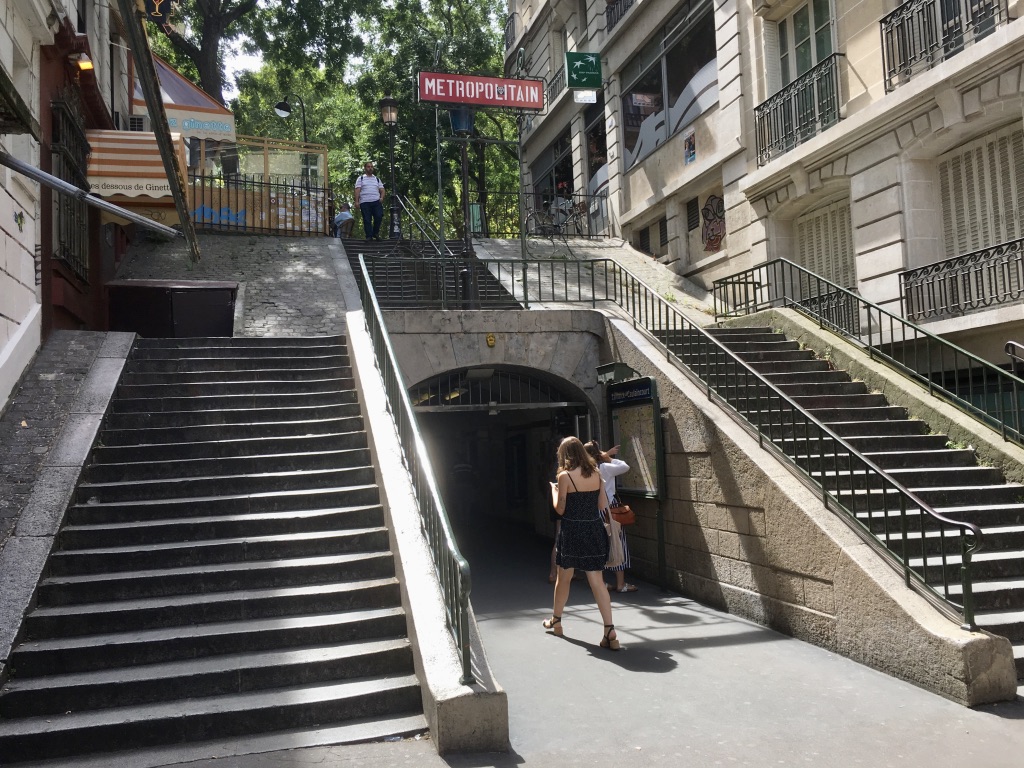
Tourists and Pigeons
IT IS ESTIMATED THAT between 30,000 and 50,000 people visit the Cathedrale Notre-Dame de Paris every day. It’s not surprising then that the queue waiting to get into the cathedral is often longer than the cathedral itself.
The queue stretches across the Parvis Notre-Dame, the square in front of the cathedral, which was renamed Parvis Notre-Dame – Place Jean-Paul II in 2006 in honour of Pope Jean-Paul II who died the previous year.
The square is a magnet for tourists who, as well as visiting the cathedral, often queue up to have their photograph taken at a small octagonal bronze plaque surrounded by a circular stone embedded into the ground bearing the legend, ‘Point zéro des routes de France’.

As the legend suggests, this is point zero, the point from which all distances from Paris to the rest of France are measured.
Visitors to this spot might not know though that this was once the site of the infamous l’Echelle de Justice, the pillory before which the condemned, with bare head and feet and with a rope around their neck and a placard on their chest and back describing their crime, were require to kneel, publicly acknowledge their crime and seek absolution. It was here in March 1314 for example, that Jacques de Molay, Grand Master of the Templars, heard the Pope’s decree condemning him to be burned alive!

Tourists weary of standing in line to visit the cathedral or jostling to take a look at point zero often gravitate towards the side of the parvis closest to la Seine to feed, or to be swamped by, huge flocks of pigeons.

Tourists and Pigeons:

Unlike the Cathedrale Notre-Dame de Paris, or point zero, or even the fabulous Crypte Archeologique du Parvis Notre-Dame, which lies underneath the parvis, these sounds of tourists and pigeons may not feature in the tourist guide books, but for me at least they are some of the quintessential summer sounds of Paris.

Place du Caire and its Sounds
THE PLACE DU CAIRE is a triangular Parisian square at the northern end of the 2nd arrondissement. Flanked by rue d’Aboukir and rue du Caire, place du Caire lies in the heart of an area of Paris known as a multicultural textile and garment manufacturing district and more recently, home to many Internet start-up companies.

Along with the Passage du Caire, one of the oldest Parisian passages couverts, the place du Caire dates from 1798. Both the Passage du Caire and place du Caire take their name from the Egyptian capital, Cairo, a place much in vogue at the time as Napoleon’s campaign in Egypt and Syria (1798 – 1801) was unfolding. As well as the military objectives of defending French trade interests and weakening Britain’s access to India, Napoleon also took a group of scientists with him to establish scientific enterprise in the region. The scientists began to describe and illustrate the country’s natural resources and cultural heritage, from the geology, flora and fauna to the various ancient structures. This gave rise to a fascination with all things Egyptian, a fascination that manifested itself on the streets of Paris.
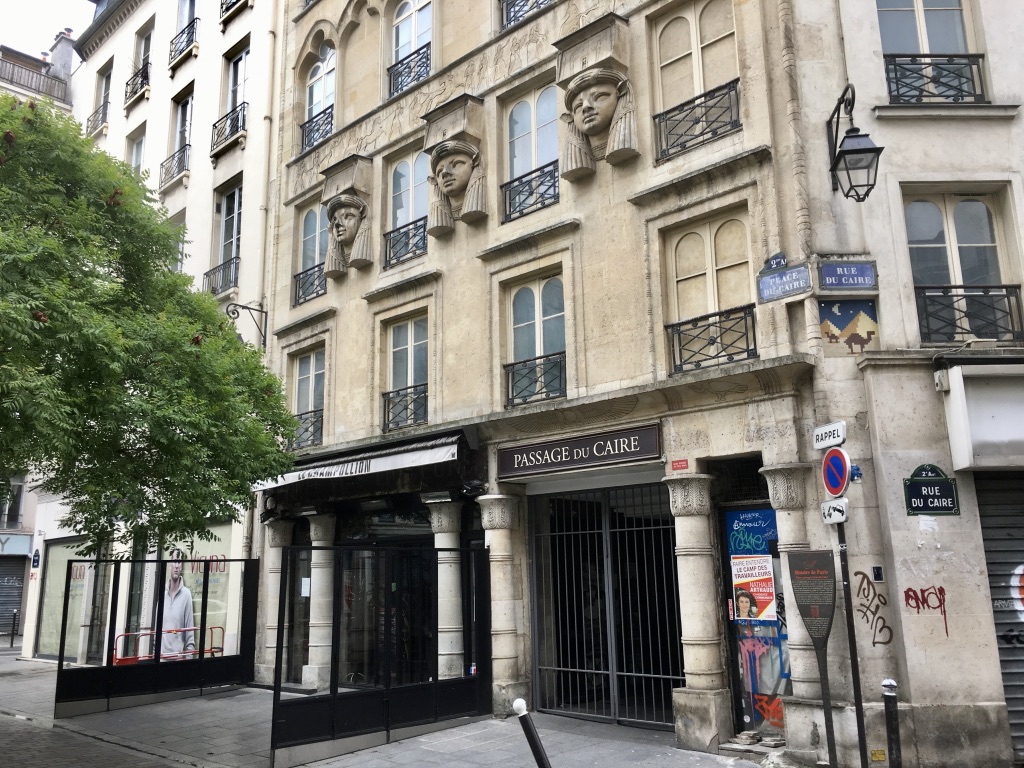
The oriental influence was reflected in some of the street names, rue du Caire, rue d’Aboukir and rue du Nil for example, but also in architecture. One example of this is the neo-Egyptian building in place du Caire.

It was built in 1799 and the large heads ornamenting the façade represent the goddess Hathor, who personified the principles of joy, feminine love, and motherhood. Above Hathor is an Egyptian inspired decorative frieze and vaguely Moorish arched trefoil windows.

Maison de style néo-égyptien sur la place du Caire- Photo d’Eugène Atget, 1903
While the place du Caire unashamedly boasts its Egyptian influence there is another chapter in this Parisian square’s history that is less obvious.
In medieval Paris a large portion of the population relied on begging for survival. Since begging was a competitive business, those with the most severe handicaps could expect more alms. It was therefore quite common for beggars to fake unsightly infirmities, injuries or dieseases. Once their day’s work was done, the beggars would return to their slums where miraculously the blind could see again and the crippled walk. This phenomenon gave the generic name to these areas where so many ‘miracles’ occurred every day: the cour des miracles, the courtyard of miracles.

The cour des miracles as imagined by Gustave Doré in an illustration to The Hunchback of Notre-Dame.
Referring to the cour des miracles in Victor Hugo’s The Hunchback of Notre Dame, Pierre Gringoire, the struggling playwright and philosopher says, “Miracles, upon my soul! Here the blind see, and the lame run.”
The cour des miracles were the haunts of thieves, beggars, prostitutes, pimps and other marginalised people. In Paris there were a dozen of them, the most famous of which was in the Sentier district between place du Caire and rue Réaumur. This is the cour des miracles Victor Hugo was referring to.
Hugo’s cour des miracles consisted of three interconnected courtyards, the main one being the loop formed by the rue de Damiette and rue des Forges. It was accessed by the present day rue du Nil, or by an alley, now disappeared, at 100 rue Réaumur.

N°100 rue Réaumur – once an entrance to the cour des miracles du Sentier,
Work to clean up the cour des miracles began in 1667 when Gabriel Nicolas de la Reynie, holder of the new office of Lieutenant General of Police, was charged with curbing the growth of crime but it wasn’t until 1750, when some of the slums were demolished and more respectable trades like blacksmiths and fishmongers moved in that improvement began. The last vestiges of the old cour des miracles were eliminated with the Haussmannisation of the area in the 19th century.

Listening to and recording the sounds of Paris is my way of exploring the city. The sounds invariably arouse my curiosity about the social and cultural history of the places in which they occur. It was listening to the sounds in the place du Caire for example that led me to discover the Egyptian connection and the history of the cour des miracles.
But as well as opening a window on the social and cultural historical connections, for me at least the sounds of a place have an absolute value in their own right. Listened to attentively, sounds can paint a picture of and tell a story about a place.
So what does the place du Caire sound like?
Today, the place du Caire still has its share of mendicants but no more than many other areas of the city. On a normal working day it’s a hustling, bustling, multi-cultural part of the city with people going about their every day business.
Sounds in the place du Caire on a normal working day:
So, is this what the place du Caire sounds like?
Well, yes it is – at least some of the time. But there are times when it sounds completely different, when the sounds have a different story to tell.
More sounds in the place du Caire:
I recorded these sounds last Monday, a public holiday in France, when all the boutiques and the passage du Caire were closed. In this different atmosphere all the sounds usually subsumed by the more aggressive sounds of a normal working day are now free to take centre stage.

The piece begins with the sound of a man with an artificial leg walking by; not a refugee from the former cour des miracles but a middle-aged man out for a stroll with his wife. A mendicant wearing sandals approaches me but then thinks better of it. The normally drowned out sounds of pigeons cooing can clearly be heard. The sound of passing two-wheelers fuelled by testosterone is inevitable. The most characteristic sounds are those very familiar to Parisian apartment dwellers like me – the sounds of an apartment gardien on one side and a gardienne on the other bringing out the refuse bins and lining them up on the trottoir ready for collection later in the day. There is even the sound of a lady, under the gaze of Olivier Brice’s ‘L’Homme au Bras Leve’, walking her cat on a leash.
For those just passing through the place du Caire, the sounds to be found there on a normal working day will perhaps be the most familiar. But I hope I have shown that these sounds don’t represent everything the place du Caire has to say.

International Women’s Day 2017
IN 2014, I MARKED International Women’s Day on this blog with a visit to the Marie Curie Museum in the 5th arrondissement to see an exhibition in the museum garden of photographic portraits celebrating the careers of prominent women, past and present, who worked or who are currently working in the fields of science and medicine. You can see my report on the exhibition here.
To mark International Women’s Day in 2015 I recorded a women’s march in Paris, the Marche Mondiale des Femmes, which you can see here.
For some reason that escapes me, I didn’t mark International Women’s Day last year so I thought I ought to make up for that lapse by coming up with something for this year.

International Women’s Day 2017 was yesterday, 8th March, and I spent the afternoon in the 1st arrondissement here in Paris. It’s a neighbourhood I pass through frequently but, although it’s one of the most exclusive and opulent parts of the city, it’s by no means my favourite part. I’m rather like the man in Nina Simone’s ‘My Baby Just Cares For Me’ – I don’t care much ‘for high-tone places’.
Still, the 1st arrondissement did set me thinking about International Women’s day.

The Ritz Hotel, Place Vendôme, 1st Arrondissement, Paris
Apart from the Musée du Louvre and the Jardin des Tuileries, the 1st arrondissement is perhaps best known for the Place Vendôme. With it’s Ritz Hotel, it’s elegant Hôtels particuliers and establishments like Boucheron, Chaumet, Van Cleef & Arpels, and Cartier, some of the world’s finest jewellery houses, the Place Vendôme attracts a regular clientele of European royals, Middle Eastern sheikhs and billionaires from all over the world. Undoubtedly, it’s one of Nina Simone’s ‘high-tone’ places.
A few steps away from the Place Vendôme though is another street, much less elegant and opulent but a street I know well: Rue Danielle Casanova.

Originally known as rue Neuve-des-Petits-Champs, the street dates back to the early seventeenth century when it was then part of the rue des Petits-Champs. It acquired the name Danielle Casanova in December 1944.
The street is named in honour of Danielle Casanova, a militant communist, a tireless activist, a member of the French resistance and a remarkable woman.

Danielle trained as a dentist in Paris and in 1928 joined the Communist Youth movement eventually becoming a member of its Central Committee. In 1936, she became the first president of L’Union des jeunes filles de France (UJFF).
The UJFF was founded partly as a response to the resentment of young communist militants who had little responsibility within the then young French Communist Movement, and partly as a way for the French Communist Party (PCF) to recruit young female members.
Danielle and the other founders of the organisation wanted to focus on issues related to all areas of gender equality: work (referring in particular to the difficulties encountered by Marie Curie in her career), education and leisure. They emphasised the double discrimination of women from the working class due to both gender and social background. The UJFF supported the Republicans during the Spanish Civil War, participating in demonstrations of support and welcoming refugee children from Spain.
After the fall of France in 1940, the French Communist Party and its related organisations were banned and Danielle went into hiding. Working underground, she helped set up women’s committees in the Paris region, she wrote for the underground press, especially Pensée Libre (“Free Thought”) and she founded la Voix des Femmes (“Women’s Voice”). She also helped organise resistance against the occupying forces,
French Police arrested Danielle on 15 February 1942 and she was transported to Auschwitz where she worked in the camp infirmary as a dentist. While in Auschwitz, she continued campaigning and organising clandestine publications and events. She died of typhus on 9th May 1943.
Danielle Casanova was a heroine of the women’s movement and the French Resistance and she has lent her name to streets, schools, and colleges throughout France.

Rue Danielle Casanova:

And I might have left my contribution to International Women’s Day there had I not called into the Café Bourbon in rue Danielle Casanova.

After living in Paris for the past eighteen years I know the 1st arrondissement reasonably well, although I don’t claim to know every nook and cranny. So while sitting in the café with time on my hands, I launched Google Maps to see if there were any streets I had yet to explore … and what I found was astonishing.
The 1st arrondissement is the least populated of the city’s twenty arrondissements and one of the smallest by area and yet I discovered that it contains 182 streets.
Paris streets are mostly named after people, professions, places or events so, since it was International Women’s Day, I decided to count up how many of those streets were named after women.
Out of the 182 streets in the 1st arrondissement, just SEVEN are named after women:
Place Colette: Named after Sidonie-Gabrielle Colette, (1873–1954) a French novelist nominated for the Nobel Prize in Literature in 1948.
Place Marguerite-de-Navarre: (1492-1549), sister of King François Ist
Rue Sainte-Anne: Anne of Austria (1601–1666), queen consort of France and Navarre, regent for her son, Louis XIV of France, and a Spanish and Portuguese Infanta by birth.
Rue Thérèse: Marie-Thérèse (1638-1683), wife of Louis XIV
Passage de la Reine-de-Hongrie: Named after a merchant from the neighbouring Les Halles, Julie Bécheur, who lived in the late eighteenth century. She was said to resemble the Archduchess Maria Theresa of Austria, queen of Hungary (and of Bohemia).
Avenue Victoria: Named after the British Queen Victoria who paid a visit to the nearby Hôtel de Ville in 1855.
And of course:
Rue Danielle Casanova:
Two more streets are named after exclusively female professions:
Rue des Lavandières-Sainte-Opportune: – the washerwomen
Rue de la Lingerie: – the seamstresses
In fact, to be precise, there are only six-and-a-half streets named after women in the 1st arrondissement rather than seven. The Rue Danielle Casanova is bisected by the boundary of the 1st and 2nd arrondissements so half the street is in the 1st and, as can be seen by the sign below, the other half is in the 2nd.

It seems that, despite having a female Mayor, the Paris City authorities still have more work to do on the gender equality of Parisian street names.
From January to June
ALTHOUGH PERHAPS NOT quite yet an obsession, searching for quiet in the busy, traffic strewn city of Paris has become a major preoccupation for me, even though it is a Sisyphean task since quiet is a rare commodity in the Parisian soundscape.
Just to be clear, for me quiet isn’t necessarily the absence of noise, but rather a state where individual sounds, which are always there but usually shrouded in a cloak of more aggressive, often unwelcome sounds, are allowed to speak and tell their own story.
Aggressive and unwelcome sounds can be found in abundance at any of the major road intersections in Paris, intersections like Place de la Bastille for example, which straddles the 4th, 11th and 12th arrondissements. Seven roads converge here, each spewing a toxic ribbon of traffic around the 1830 July Column.
One might be forgiven for thinking that amidst the cacophonous noise pollution around Place de la Bastille quiet might be elusive, but it can be found if one searches diligently.
One of the streets leading from Place de la Bastille is Rue de la Roquette, a seventeenth century street once home to the French poet Paul Verlaine, the dramatist Michel-Jean Sedaine, the historian Jules Michelet and, for a time in the 1980s, the celebrity chef and restaurateur Gordon Ramsay. At N°2 Rue de la Roquette is a seventeenth century archway leading into the Passage du Cheval Blanc.
Once home to timber warehouses supplying the cabinetmakers and furniture manufacturers close by, today the Passage du Cheval Blanc comprises a labyrinth of individual passageways and courtyards housing small businesses from the Maison Lucien Gau, specialising in the creation, conservation and restoration of lighting and bronze art objects, to architects’ offices and design studios as well as the studios of the radio station Oui FM.
Maison Lucien Gau
Walking from Place de la Bastille through the seventeenth century archway into the Passage du Cheval Blanc the atmosphere changes: the cacophony of Place de la Bastille gradually fades giving way to the indigenous sounds of the passage itself and a calming quietness.
Sounds inside the Passage du Cheval Blanc:
A distinguishing feature of the Passage du Cheval Blanc is that each of the interior passageways is named after a month of the year from January to June.
January
February
March
April – It’s not actually a passageway but a staircase
May
June
The sound piece above is my soundwalk from January to June and back to January again.
I have long held the view that constant, aggressive and unwelcome sounds are just as polluting and damaging to our health as the other sources that pollute our atmosphere with a plethora of toxic emissions. Walking through the Passage du Cheval Blanc, I couldn’t help thinking about how the mainly young, creative people who work here must profit from the absence of aggressive, unwelcome sounds.
Rue Mouffetard – In the Footsteps of Eugène Atget
TRAWLING THROUGH MY Twitter feed the other day I came upon this photograph by Eugène Atget made in 1898 entitled ‘La Place Saint-Médard’.
La Place Saint-Médard by Eugène Atget 1898
The original photograph is an 18.1 x 21.9 cm albumen print created from a finely divided silver and gold image dispersed in a matrix of egg white. Albumen prints were the most common photographic printing process from 1855 until around the turn of the nineteenth century.
This Atget image chimes with me because I know this area of Paris particularly well, but when I saw the photograph I was struck by two things: First, the title, ‘La Place Saint-Médard’, and second, what did this place sound like in 1898?
The title of the photograph, ‘La Place Saint-Médard’ is curious because that name does not exist in this spot today and, so far as I know, it never has. I can quite see why Eugène Atget might have thought that the space he photographed bore that name: It is at the foot of rue Mouffetard, one of the oldest streets in Paris dating back to Roman times and it is adjacent to the Eglise Saint-Médard whose origins date back to the 7th century. The space that Atget photographed does have the attributes of a typical Parisian ‘Place’ but as far as I can establish it is, and in Atget’s time was, part of rue Mouffetard.
Eugène Atget’s ‘La Place Saint-Médard’ on December 24th 2016
So what did Eugène Atget’s ‘Place Saint-Médard’ sound like in 1898?
Thanks to his large-format wooden bellows camera, rapid rectilinear lens and glass plates we know what Atget saw as he stood in this place but we have no record of what he actually heard.
And that’s not surprising because for most of our history we have used artefacts, architecture, pictures and words to create a vision of our past. It’s only in the last few seconds on our historical clock that we’ve been able to capture and archive sound, which means that almost all our sonic heritage has passed by completely unrecorded.
We could create a late nineteenth century soundscape of this place from our imagination of course and we might not be too wide of the mark, but we cannot create the actual sounds in that place on that day.
I admire enormously Eugène Atget’s painstaking documentation of a nineteenth-century Paris undergoing great change and I consider it a great privilege to follow in his footsteps documenting contemporary Paris in sound.
Eugène Atget’s ‘Place Saint-Médard’ – Recorded on December 24th 2016:
A Christmas Eve queue for the boulangerie close to Eugène Atget’s ‘Place Saint-Médard’



